We may not have the course you’re looking for. If you enquire or give us a call on 01344203999 and speak to our training experts, we may still be able to help with your training requirements.
Training Outcomes Within Your Budget!
We ensure quality, budget-alignment, and timely delivery by our expert instructors.
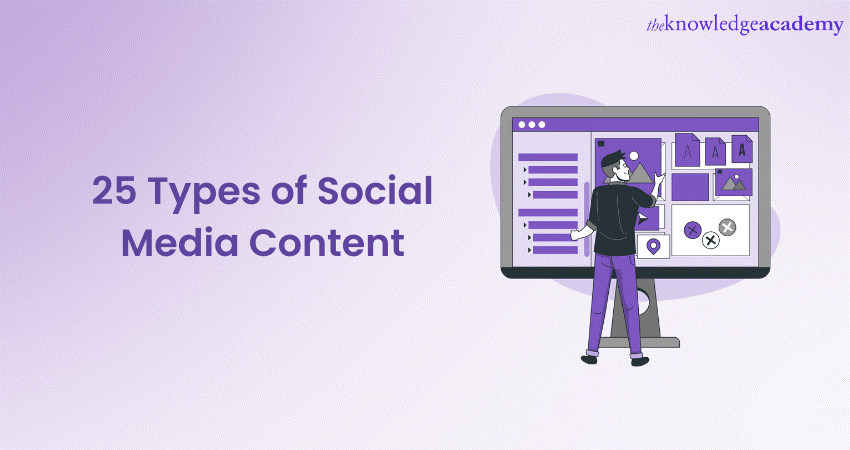
Social media has become a powerful platform for connecting with audiences, building brand presence, and sharing content. As the world of social media continues to evolve, so does the diversity of content that populates these platforms. HubSpot reveals that 42% of marketers utilise social media, recognising it as the most lucrative channel with the highest ROI. Given this perspective, sharing content on social media for marketing purposes is a smart choice.
However, to develop an effective social media strategy, it's important to understand the various Types of Social Media Content that can capture attention, convey messages, and encourage meaningful interactions. In this blog, we'll explore 25 different Types of Social Media Content that can help you engage and captivate your target audience.
Table of Contents
1) Why diversifying Social Media Content matters?
2) 25 Types of Social Media Content
a) Types of visual content
b) Text-based contents
c) Types of interactive content
d) User-Generated Content (UGC)
e) Educational content
3) Conclusion
Why diversifying Social Media Content matters?
Social Media Content is the canvas where brands connect, tell their stories, and form strong relationships with followers. Diversifying your Social Media Content isn't just a trend; it's a necessity that holds the potential to transform your brand's online presence. But why does it matter so much?
Different types of content cater to various audience preferences and help maintain a vibrant online presence. They help businesses in:
a) Capturing attention
b) Appealing to varied preferences
c) Enhancing engagement
d) Building trust and authenticity
e) Adapting to platform dynamics
f) Overcoming content fatigue
25 Types of Social Media Contents
Content educates, informs, and entertains, allowing brands to establish authority and credibility. There are various Types of Social Media Content, each tailored to specific platforms and audiences. Below are five common Types of Social Media Content:
Types of visual content
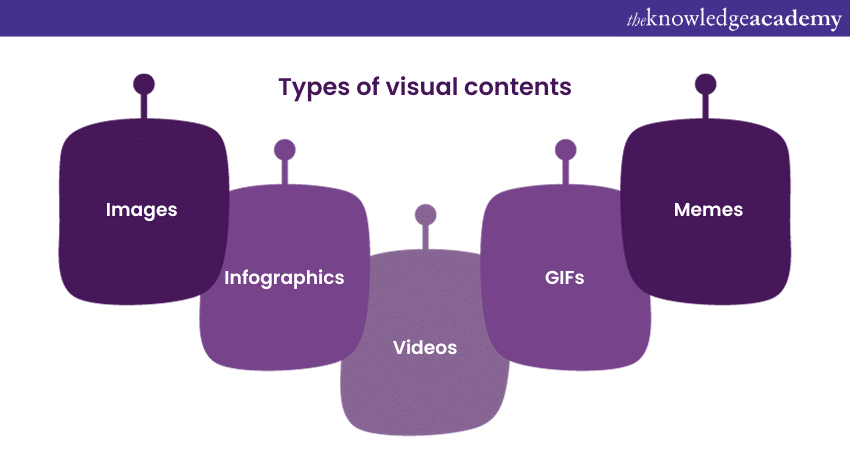
Visual content is one of the influential tools at your disposal for making an impact on social media platforms. It's engaging, easily shareable, and can convey a message in seconds. Here are five popular types of visual content that can boost your social media strategy:
1) Images: Images are the building blocks of visual content on social media. They have the ability to convey emotions, showcase products, and tell stories all in a single glance. To make the most of images:
a) High quality: Use high-resolution images to ensure they appear clear and professional.
b) Relevance: Ensure the images align with your brand's identity and the message you want to pass on.
c) Storytelling: Craft images that narrate a story, whether it's about a product's journey, a customer's experience, or a behind-the-scenes look
2) Infographics: Infographics are basically visual representations of complex information or data. They are designed to simplify concepts and make them easy to understand and share. These types of content also become quickly viral. Here's how to effectively utilise infographics for your social media:
a) Data visualisation: Use graphs, charts, and diagrams to present statistics and data points in a visually appealing manner.
b) Clear hierarchy: Arrange information in a logical order, guiding the viewer's eye from top to bottom, left to right.
c) Branding: Incorporate your brand's colours, logo, and fonts to maintain consistency.
3) Videos: Videos have become a dominant form of content on social media due to their engaging nature. More than 80% of Social Media Marketers say that using videos directly increases sales. They can range from short, attention-grabbing clips to longer-form content like tutorials and behind-the-scenes looks:

a) Variety: Create diverse videos, including product demos, vlogs, behind-the-scenes content, tutorials, interviews, and more.
b) Storytelling: Craft videos with a compelling narrative that draws viewers in and keeps them engaged
c) Call to Action (CTA): Encourage viewers to take specific actions at the end of the video, such as liking, sharing, or visiting your website.
4) Memes: Memes are the currency of internet humour. They are humorous images paired with text that tap into cultural trends, inside jokes, or relatable situations. Using memes in your content strategy can add a touch of humour and personality:
a) Stay relevant: Use current memes that your target audience can relate to.
b) Stay positive: Ensure your memes are light-hearted and align with your brand's tone.
c) Avoid offence: Be cautious not to use memes that could be offensive or polarising to your brand.
5) GIFs: Graphics Interchange Formats (GIFs) are short, looped animations that add an element of dynamism to your content. They're perfect for conveying emotions and reactions or illustrating step-by-step processes. They are particularly engaging and can be used in various ways:
a) Express emotions: Use GIFs to showcase reactions, emotions, and feelings that resonate with your audience.
b) Product demos: Create GIFs to demonstrate how your product works or showcase its features in action.
c) Storytelling: Use GIFs to create visual narratives or tell short stories.
Text-based content
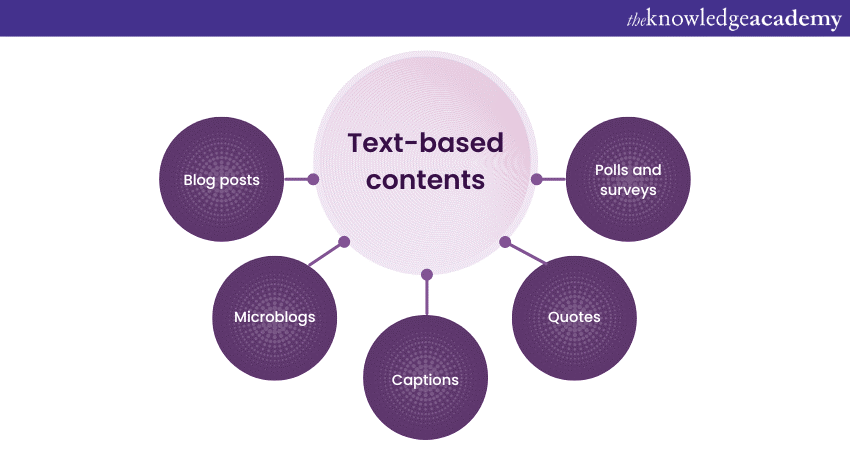
While visuals grab attention, well-crafted written content provides context, depth, and the opportunity for meaningful engagement. Here are five types of written content that can enhance your social media presence:
1) Blog posts: Blog posts or articles are the go-to choice for many Social Media Marketers. They allow you to delve into topics in-depth, providing valuable insights and actionable information to your audience. Blogging positions you as an industry authority and encourages followers to see your brand as a reliable source of knowledge. Consider the following tips for compelling blog posts:
a) Choose relevant topics: Address topics that align with your industry, address common pain points, and answer frequently asked questions from your audience.
b) Provide value: Offer valuable insights, data, case studies, or how-to guides that help your audience solve problems or achieve their goals.
c) Use visuals: Incorporate images, infographics, or graphs to break up texts to make your content more engaging.
d) Promote on social media: Share snippets or teasers from your blog posts on social media to drive traffic to your website.
2) Microblogs: Microblogs are short snippets of text that allow you to share quick updates, thoughts, or links with your audience. Platforms like Twitter and LinkedIn are popular for microblogging. Here's how to make the most of microblogs:
a) Get to the point: Since character limits are often imposed on microblogging platforms, be concise in conveying your message.
b) Share insights: Offer quick insights, industry news, or thought-provoking questions that encourage engagement and discussion.
c) Use hashtags: Incorporate relevant hashtags to increase the visibility of your microblogs and make them discoverable to a wider audience.
3) Captions: Captions are essential for providing context and sparking engagement in your visual content. A compelling caption can transform a simple image or video into a meaningful story. Here's how to craft effective captions:
a) Tell a story: Use captions to provide background information, tell anecdotes, or share personal experiences related to the visual content.
b) Ask questions: Pose questions that encourage your audience to share their opinions in the comments.
c) Use emojis: Emojis can add personality and emphasis to your captions, making them more engaging.
4) Quotes: Inspirational or thought-provoking quotes resonate well with audiences as they provide a moment of reflection and connection. Share relevant quotes to foster a positive and relatable image:
a) Align with your brand: Choose quotes that resonate with your brand's identity and messaging.
b) Create visual quotes: Overlay quotes onto eye-catching images to make them stand out in users' feeds.
c) Use in various contexts: Share quotes that align with different themes, such as motivation, success, or industry-specific insights.
5) Polls and surveys: Polls and surveys are interactive written content that directly involves your audience in your content strategy. They provide valuable insights while encouraging participation. Consider the following tips for using polls and surveys:
a) Audience preferences: Ask your audience about their preferences, such as favourite products, content topics, or future plans.
b) User-generated ideas: Seek suggestions from your audience on what they would like to see from your brand in the future.
c) Feedback and improvement: Use polls to gather feedback on your products, services, or recent campaigns and showcase that you value your audience's opinions.
Master the art of marketing with our Introduction to Marketing Training - Register today and pave the way for your marketing success!
Types of interactive content
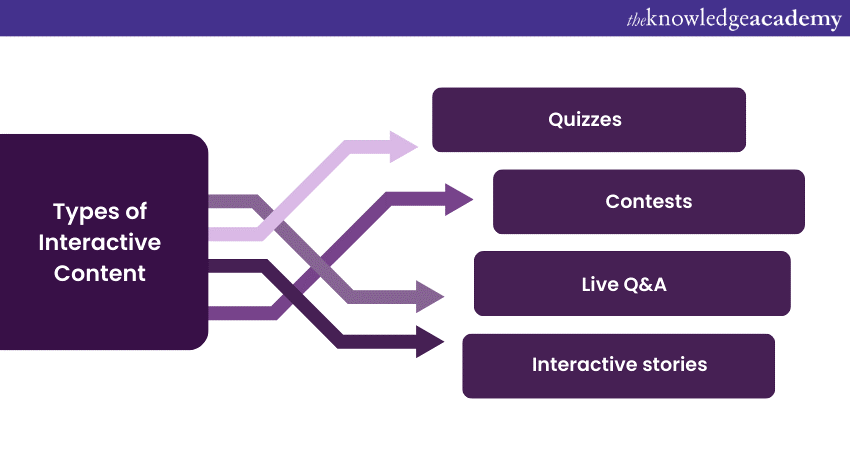
Interactive content takes engagement to the next level by involving your audience directly in content creation. Here are five types of interactive content that encourage active participation:
1) Quizzes: Quizzes are both entertaining and informative. They allow you to create a personalised experience for your audience while gathering insights about their preferences and behaviours.
a) Relevance: Design quizzes that align with your industry, products, or services while still being enjoyable for participants.
b) Segmentation: Use quiz results to segment your audience based on their responses, enabling you to deliver more targeted content.
c) Shareability: Encourage participants to share their results, spreading your brand's reach.
2) Contests: Contests and giveaways create excitement and incentivise engagement among your audience. They can quickly increase your brand's visibility and attract new followers:
a) Clear rules: Clearly outline the rules, entry requirements, and deadlines for participants to follow.
b) Prizes: Offer enticing rewards that resonate with your target audience and encourage participation.
c) User-generated content: Require participants to submit their own content (photos or videos) related to your brand, expanding your UGC pool.
3) Live Q&A: Live Q&A sessions allow you to connect with your audience in real time. Address their questions, concerns, and comments directly, building a sense of trust and community. Live sessions also humanise your brand by showcasing the people behind it:
a) Announcements: Promote your live session in advance to ensure your audience knows when to join.
b) Preparation: Prepare answers to common questions and consider having a moderator to manage incoming questions.
c) Authenticity: Show your brand's personality and expertise by addressing questions with genuine and informative responses.
4) Interactive stories: Interactive stories are available on platforms like Instagram and Facebook and allow you to create engaging content that users can interact with directly:
a) Polls and quizzes: Use the built-in features to create polls, quizzes, and questions that users can answer as they view your story.
b) Swipe-up links: Utilise swipe-up links to direct users to specific landing pages, blog posts, or products.
c) Countdowns and questions: Add countdown timers for upcoming events or ask open-ended questions to encourage audience participation.
User-Generated Contents (UGC)
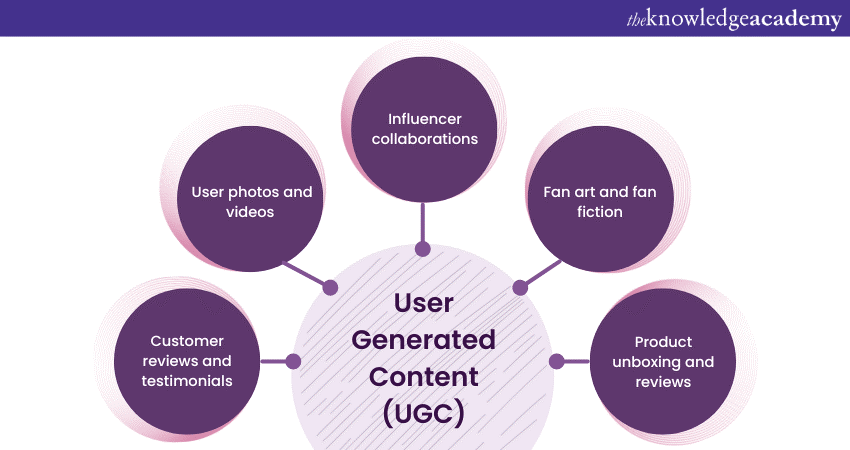
User-Generated Content (UGC) is an effective method to leverage your audience's creativity, enthusiasm, and authenticity to enhance your brand's presence on social media. Let's delve deeper into five specific types of UGC that can strengthen your brand and foster a sense of community:
1) Customer reviews and testimonials: Customer reviews and testimonials showcase real-life experiences with your products or services. They build trust and credibility, influencing potential customers' purchasing decisions:
a) Encouragement: Encourage satisfied customers to leave reviews on platforms like Google, Yelp, and your social media pages.
b) Showcase diversity: Highlight a range of customer demographics and experiences to resonate with a wider audience.
c) Engagement: Respond to reviews, be it positive or negative, to show that you appreciate feedback and are committed to improving
2) User photos and videos: User photos and videos feature customers using your products in real-world situations. This UGC provides social proof and adds a personal touch to your brand:
a) Branded hashtags: Create a unique hashtag that customers can use when sharing their content, making it easy to find and share.
b) Reposts: Repost user-generated content on your brand's social media, giving credit to the creators and showing appreciation.
c) Variety: Encourage users to share different types of content, such as unboxing videos, tutorials, or product demonstrations.
3) Influencer collaborations: Influencer collaborations involve partnering with individuals who have a significant online following. Influencers can introduce your brand to a broader audience and provide authentic recommendations:
a) Research: Choose influencers whose values align with your brand's image and target audience.
b) Authenticity: Encourage influencers to create natural and genuine content, avoiding overly scripted promotions.
c) Long-term relationships: Consider establishing ongoing partnerships with influencers to maintain consistent exposure.
4) Fan art and fan fiction: For industries with dedicated fan bases, sharing fan art and fan fiction can foster a sense of community and show appreciation for your customers' creative efforts:
a) Promotion: Showcase fan-created content on your social media platforms to celebrate the creativity of your audience
b) Contests: Host contests encouraging fans to submit their own creations, offering prizes and recognition for the best entries.
c) Respect copyright: Always credit the creators and ask for permission before sharing their content.
5) Product unboxing and reviews: Product unboxing and reviews provide potential customers with an authentic view of your products and services in action. They help build confidence in your offerings:
a) Unbiased opinions: Allow customers to share their honest opinions, even if they are critical, as this builds trust and credibility.
b) User-focused: Share content focusing on the user experience, highlighting benefits, features, and real-world usage.
c) Acknowledgement: Respond to product unboxing and review content with gratitude and acknowledgement.
Educational content
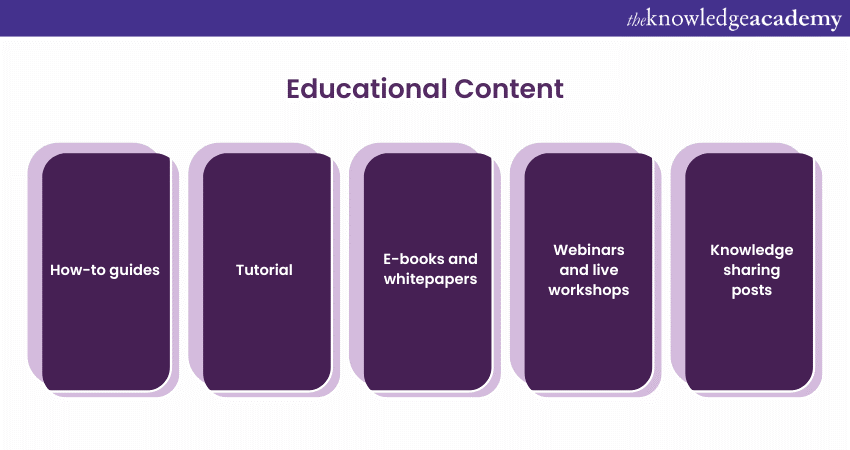
Educational content is a valuable way to provide your audience with information, insights, and skills that they can benefit from. Let's explore five types of educational content that can position your brand/ business as a trusted source of knowledge:
1) How-to guides: How-to guides are detailed instructions that guide your audience through completing specific tasks or solving problems. They establish your brand's authority by demonstrating expertise and offering practical value:
a) Step-by-step: Break down complex processes into clear, actionable steps to help users achieve their goals.
b) Visual aids: Use images, screenshots, or diagrams to illustrate each step and enhance understanding.
c) Variety: Create how-to guides that are relevant to your industry, products, or services.
2) Tutorials: Tutorials provide visual demonstrations of processes or skills, making complex tasks easier to understand. Video tutorials, in particular, are highly engaging and effective:
a) Hands-on approach: Show your audience how to use your products, software, or tools through practical demonstrations.
b) Clarity: Clearly explain each step while considering the skill level of your target audience.
c) Problem-solving: Address common challenges your audience faces and provide solutions through tutorials.
3) E-books and whitepapers: E-books and whitepapers offer in-depth insights on specific topics, showcasing your brand's expertise and thought leadership:
a) Valuable content: Deliver high-quality, research-driven content with unique insights and information.
b) Lead generation: Offer e-books and whitepapers in exchange for user contact information to grow your mailing list.
c) Distribution: Promote your e-books and whitepapers on social media, your website, and email marketing campaigns.
4) Webinars and live workshops: Webinars and live workshops provide real-time interactions and learning experiences for your audience. They allow you to connect directly with participants and answer their questions:
a) Educational value: Offer valuable insights, best practices, and actionable strategies during the live session.
b) Interactivity: Encourage audience participation through polls, Q&A sessions, and interactive discussions.
c) Recorded content: Make recordings of webinars and workshops available for those who couldn't attend live.
5) Knowledge sharing posts: Knowledge-sharing posts provide bite-sized pieces of industry insights, trends, news, or tips. They showcase your brand's awareness of the latest developments:
a) Stay updated: You need to keep up with industry news and trends to share timely and relevant information with your audience.
b) Analysis: Provide your perspective on industry shifts, challenges, and opportunities to demonstrate your expertise.
c) Discussion starter: Create posts that encourage your audience to share their thoughts and engage in purposeful conversations
Elevate your social media game with our Introduction to Social Media Master Class - Register now and amplify your digital marketing skills!
Conclusion
Creating a compelling content strategy is of utmost important for brands and individuals alike. Diversifying your Social Media Content strategy by incorporating various types of content is essential for engaging your audience, building brand loyalty, and achieving your marketing goals. By exploring and leveraging the above types of content, you can create a comprehensive and attractive social media presence that resonates with your target audience.
Unlock the secrets of impactful content marketing with our Content Marketing Masterclass - Enrol now and elevate your digital presence!
Frequently Asked Questions
Upcoming Digital Marketing Resources Batches & Dates
Date
 Social Media Marketing Course
Social Media Marketing Course
Fri 17th Jan 2025
Fri 21st Mar 2025
Fri 16th May 2025
Fri 18th Jul 2025
Fri 19th Sep 2025
Fri 21st Nov 2025







 Top Rated Course
Top Rated Course



 If you wish to make any changes to your course, please
If you wish to make any changes to your course, please


